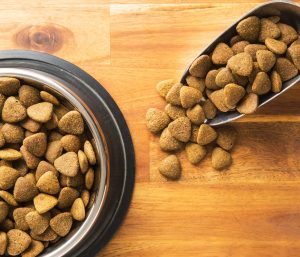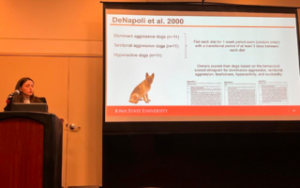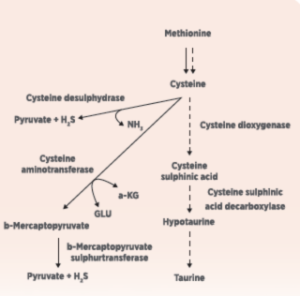Companion Animal Nutrition at the ASAS Meeting
The annual meeting of the American Society of Animal Science was held between July 16 and 20 at the Albuquerque Convention Center in New Mexico. This annual scientific event brings many animal nutrition sessions, among many other topics such as breeding, genetics and genomics, precision livestock farming and management, health, growth and development, physiology and reproduction, teaching, training, and extension.
In animal nutrition, there are sections for ruminant and monogastric nutrition. However, in the past years, the companion animal nutrition section has been growing. This year, four sessions were dedicated to companion animals, and nutrition was the primary focus. Additionally, 30 posters were presented on topics related to pet food.
These presentations covered a great variety of topics that included:
- feeding and weight control,
- amino acid digestibility and metabolism,
- evaluation of feedstuffs and pet food products,
- alternative ingredients, including insect food,
- trace mineral and vitamin nutrition,
- fiber utilization,
- methodologies to determine energy and digestibility values for pet food,
- impact of diverse feed additives on gut health,
- governmental regulations, pet owner consumer trends,
- implications of processing and handling on the functionality of plant and animal-derived products for pet food.
This meeting delved into numerous captivating aspects of companion animal nutrition. Yet, given our article’s space constraints, we’ve opted to summarize specific papers focused on amino acid digestibility, requirements, and metabolism, due to the importance of these nutrients for dogs and cats.
Amino acid digestibility for pet food ingredients
Estimating the amino acid digestibility of protein sources for pet foods is challenging. Nutritional research in companion animals has many limitations compared to farm animals. Precision-fed customized rooster assays are used to obtain digestibility since correlations between rooster and dog data are high, r = 0.90 for total essential amino acids and r = 0.92 for total amino acids. These data are used to estimate the digestible indispensable amino acid score or DIAAS-like values. These DIAAS values provide the amino acid quality of food proteins based on ileal digestibility studies rather than total tract digestibility, and values for each amino acid may be calculated.
This is the formula used to estimate DIAAS-like (%):
DIAAS-like (%) = 100 x mg of digestible AA in 1 g of the dietary protein
mg of the same AA in 1 g of reference protein
Pigs are recognized as an appropriate model to determine DIAAS for human food proteins, and rooster digestibility data is currently the model for pet food. Considering that digestibility values for amino acids in individual food proteins are additive in mixed meals, DIAAS values for mixed meals may be calculated. By comparing the DIAAS values of mixed meals to the requirements for digestible indispensable amino acids, the amino adequacy of the meal may be calculated.

DIAAS-like calculations estimate the protein quality of each ingredient. The limiting amino acid of each ingredient is identified using references like the National Research Council, 2006, NRC; the Association of American Feed Control Officials, AAAFCO, or the European Pet Food Industry, FEDIAF, for each life stage (growing, adult) and species (dog, cat).

A research group from the University of Illinois led by Dr. Patricia Massae used this technique to evaluate the digestibility of amino acids in the microbial protein (MP) produced by Calysta (https://calysta.com/) for pet food. Their study also included an evaluation of corn gluten meal, chicken meal, pea protein, and black soldier fly larvae as a reference.
In this study, corn gluten meal had the highest amino acid digestibilities. However, the MP evaluated had digestibilities higher than 85% for all indispensable amino acids. The lysine digestibility of MP was 92.3%, higher than all other ingredients. The MP tryptophan digestibility was 97.2%, higher than corn gluten meal and pea protein. Methionine was a limiting amino acid for MP. In conclusion, the MP is a highly digestible, high-quality protein source for companion animal diets in almost all life stages evaluated. However, to estimate additional potential effects, palatability, stool quality, and other health outcomes should be evaluated in dogs and cats.
Dr. Van Straten from Alberta also presented a study to evaluate the apparent total tract digestibility (ATTD) of extruded vegetarian dog foods in pigs and adult dogs. There were two diets:
- low protein containing 24% crude protein, including 35% field pea flour and 15% lentil flour,
- and high protein containing 43% crude protein, including 50% pea protein concentrate and 20% lentil protein concentrate.
One of the objectives of this project was to compare the digestibility of both species. The results indicated that pigs have higher digestibility than dogs. The prediction for ATTD of organic matter was R2 = 0.90 and R2 = 0.89 for crude protein. Consequently, pig digestibility values can be used to predict dog digestibility.
In the same study, an enzyme blend containing four enzymes: phytase (12-17 thousand U/kg of diet), cellulose (480-510 thousand U/kg of diet), xylanase (360-680 thousand U/kg of diet), and protease (960-1,360 thousand U/kg of diet), was added to both diets before and after extrusion. The addition of enzymes did not increase the digestibility of these dog foods. Still, it did reduce fecal quality, increasing moisture and impacting fecal metabolites, increasing acetate, propionate, glucose, and xylose.
Amino acid requirements and utilization
Dr. Julia Pezzali from Iowa State discussed functional amino acids in dogs and cats and their implications for overall health and methods to assess requirements and utilization of sulfur amino acids. Amino acids have diverse roles beyond protein synthesis and may affect their behavior, cognitive capacity, feed intake control, activity, and health.

Dr. Julia Pezzali presenting functional amino acids in dogs and cats
For example, tryptophan and tyrosine are precursors of serotonin and catecholamines, respectively. They may reduce stress anxiety-related and agonistic behavior in dogs. The surplus of arginine may improve cognitive function in aging dogs, likely by enhancing nitric oxide synthesis. Supplementation of branch-chain amino acids (leucine, isoleucine, and valine) may also improve the ability of senior dogs to sustain cognitive performance during exercise.

Cognitive dysfunction in dogs could be related to amino acid deficiencies.
In adult cats, phenylalanine may delay gastric emptying and promote satiety. These effects could be interesting in controlling appetite and preventing feline obesity. On the other hand, low phenylalanine and tyrosine plasma levels due to low dietary intake can cause reddish hair coat in black cats.

Changes in hair color in black cats due to tyrosine and phenylalanine deficiency
The DL-Methionine can help to acidify urine in cats and dogs, avoiding urinary stones. However, excess (1g DL-Methione/kg of body weight per day) can cause hemolytic anemia with a marked increase of methemoglobin (MetHb) concentration and Heinz-body formation in cats. Methionine excess can also cause hyperhomocysteinemia with the same harmful implications in cardiovascular disease, some brain issues, and behavior changes observed in other animal species.
Based on this information, it is clear that estimating optimum levels of methionine for dogs and cats is critical. Dr. Pezzali discussed this topic in her second presentation. The metabolism of the four sulfur-containing amino acids, methionine, cysteine, homocysteine, and taurine is highly related. Methionine can be used in protein synthesis or to produce homocysteine, which can be re-methylated to methionine or irreversibly catabolized to cysteine. Unlike dogs, cats cannot further metabolize cysteine to taurine, making the latter an indispensable amino acid for the cat.

General pathway of taurine synthesis in the liver from sulphur amino acids. The activities of the enzymes cysteine dioxygenase and cysteinesulphinic acid decarboxylase are low in cats, which severely restricts synthesis of taurine. Cysteine is largely metabolised to pyruvate, which provides an energy substrate whereas taurine cannot be oxidised by cats.-KG,-ketoglutarate; GLU, glutamate.
Cats have a greater need for sulfur amino acids due to differences in their metabolism.
- First, cats and other members of the Felidae family use methionine and cysteine to produce a unique sulfur amino acid called felinine. Felinine is synthesized in the liver and is excreted in the urine of all cats but is found in the highest concentration in the urine of adult, intact males. The urine of intact tomcats contains felinine concentrations up to six-fold greater than those found in castrated males and intact females. Male intact cats may have a greater requirement for the sulfur amino acids than sterilized female and male cats.
- Second, felines need to maintain a thick hair coat and have a higher need for methylation reactions during a higher rate of phospholipid synthesis than other mammalians. Increased phospholipid synthesis in cats could be necessary to absorb and transport the high-fat level usually included in a cat’s diet.
- Lastly, the cat’s requirement for dietary taurine increases the need for sulfur amino acids.
Dr. Pezzali presented the results of her research using amino acid oxidation while feeding practical experimental diets to estimate the methionine requirements. Applying this technique, her research team observed higher methionine requirements for adult cats, Labrador, and Beagle dogs, but not for Dachshunds, compared to the recommendations proposed by the NRC (2006) and AAFCO (2023). These results and others recently published also indicate differences in sulfur amino acid metabolism among dog breeds. Under specific dietary conditions, these changes can make taurine indispensable for some dog breeds. Julia highlighted the need to standardize methodologies to investigate the effects of nutritional factors on the metabolism of sulfur amino acids.
Several other research contributions presented at this event have significant practical applications, and we encourage our readers to review them in the Journal of Animal Science or to attend the next Animal Science meeting in Calgary in July 21-25, 2024.
You may also like to read: “Factors that impact Palatability in Feline Diets.”












